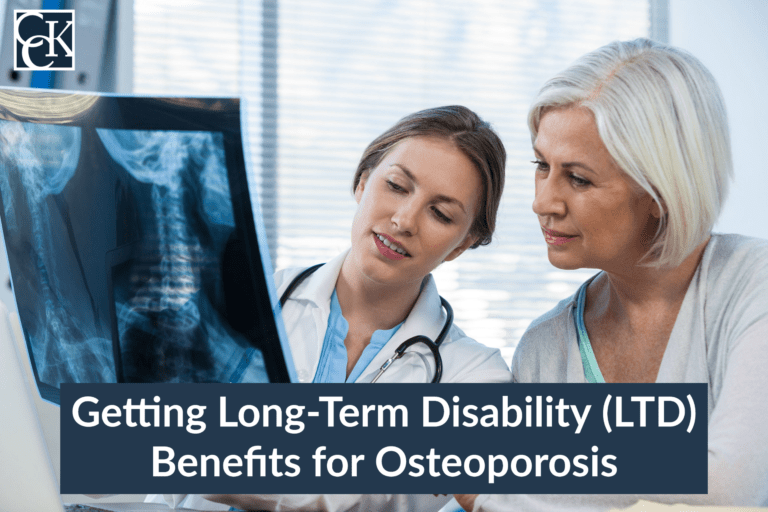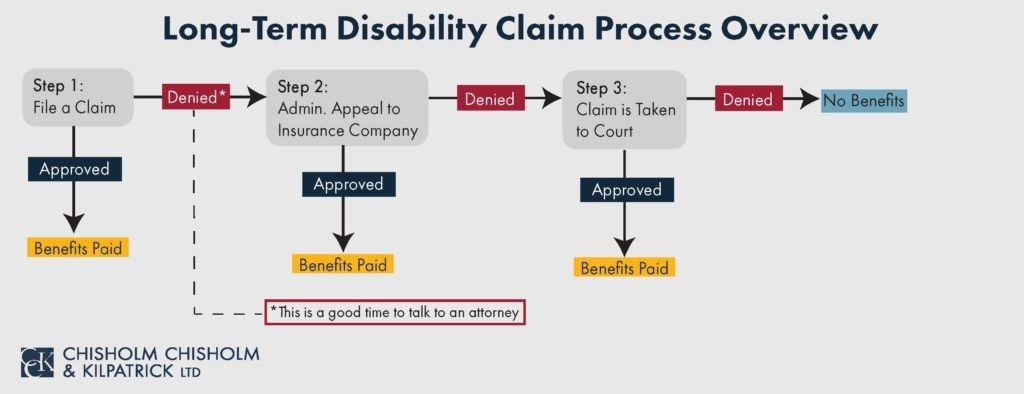Getting Long-Term Disability (LTD) Benefits for Osteoporosis

Osteoporosis is sometimes known as a “silent” disease of the bones. Osteoporosis occurs when your bone density decreases, making your bones weak and brittle. Early symptoms are not always apparent, and you might not realize you have osteoporosis until you experience a bone fracture. A diagnosis of osteoporosis may be debilitating if you find yourself too weak to perform basic functions or are in a more advanced stage of the disease. If your osteoporosis is negatively affecting your ability to perform your job, you may be eligible for long-term disability (LTD) insurance.
Filing for long-term disability benefits can be a long process, especially when you may be focused on treating your osteoporosis. Fortunately, the long-term disability lawyers at Chisholm Chisholm & Kilpatrick are able to help. If you need the assistance of an attorney to file or appeal your claim, you can call 800-544-9144 today for a free consultation.
What is Osteoporosis?
Osteoporosis is a bone condition in which bone mass decreases. The word osteoporosis translates to “porous bone,” which means the natural gaps within bone tissue have grown to an unhealthy degree, resulting in loss of bone density and strength. This causes bones to become weak, brittle, and have a much higher risk of fracturing, even when doing something that causes only mild stress. A fracture could be caused by something as minor as bending over, lifting an object that is not very heavy, or coughing. Osteoporosis can occur in any bone in the body, but most often affects the bones of the hip, wrist, or spine.

Osteoporosis can affect anyone of any age, but most commonly affects those past the age of 50, particularly women. Throughout our lives, our bones constantly break down and rebuild themselves. When we are young, the process of our bones rebuilding themselves is faster than the time it takes for them to break down, which results in strong bone mass. However, as we age this process slows, and most people reach their peak bone mass by the age of 30. After that, bone mass is lost faster than it is created, which can result in weakened bones. When your bones become weak enough to break, you may be diagnosed with osteoporosis.
The leading cause of osteoporosis is a decrease in the hormone estrogen. Osteoporosis is much more likely to occur in women because women typically have higher levels of estrogen than men. Estrogen plays an important part in bone density and protecting bone mass, and when women age and go through menopause, their estrogen levels decrease, resulting in a heightened risk for osteoporosis.
It is important to note that men can also be affected by estrogen levels, as well as testosterone levels, which can affect bone density as they decrease over time. Other risk factors such as nutrition, genetics, hormone abnormalities, and the presence of other medical conditions can increase your chance of developing osteoporosis. While osteoporosis is most common in people who are older, it can still occur in younger people. Osteoporosis can also be an effect of diseases or disorders that can affect bone mass, such as thyroid disorders, celiac disease, autoimmune disorders, cancer, and kidney or liver disease.
Symptoms and Diagnosis of Osteoporosis
Osteoporosis is often a “silent” disease because there are typically no noticeable symptoms in its early stages. It is often discovered once bones have lost significant mass and density, likely brought to attention by a bone fracture. Symptoms of weakened bones include:
- Back pain caused by damaged vertebra
- Stooped posture
- Loss of height
- Unexpected bone fracture caused by minor stresses such as bending, lifting, coughing, or falling in a manner that might not normally cause bone breakage
Older individuals are often screened for osteoporosis once they reach a certain age. A doctor may ask you about your personal and family medical history, lifestyle habits such as diet and exercise, and any history of bone pain or fractures. A routine physical examination may evaluate your height, weight, changes in posture or gait, and your muscle strength.
If osteoporosis is suspected, you may go through an x-ray test to measure the density of your bones. Typically, only select bones are tested and not the entire body. Blood tests may also be administered to rule out other diseases that could cause loss of bone mass.
Osteoporosis Treatment
Treatment for osteoporosis depends heavily on the stage of the disease. If your risk of bone breakage is low, your treatment may initially focus on lowering risk factors for injury as well as adjusting your lifestyle habits. You may be advised to alter your diet to consume more calcium-rich foods, vitamin D, and protein, or to increase your caloric intake if you are underweight. You may also be advised to exercise and build muscle with the help of a specialist or physical therapist. Increasing your strength can improve coordination and balance and decrease your risk of falling, as well as strengthen areas of muscle surrounding your bones. It is important to have the help of a professional so that you do not strain yourself and cause further injury.
You may be prescribed medication for more advanced osteoporosis. The type of medication depends heavily on your age, sex, and general health. Medication can be used to preserve existing bone density or slow bone loss. It can provide different types of hormone control or therapy, particularly related to estrogen.
Osteoporosis and Your Long-Term Disability (LTD) Claim
Whether your job is physical or sedentary, osteoporosis can affect your ability to work. If your occupation is physical, it may be clear that weak and brittle bones will affect your ability to carry out the duties of your job. Whether you are in danger of a bone fracture or one has already occurred, you may not be able to lift heavy objects, operate machinery, or do physical labor that requires a lot of movement. Even lighter physical labor, such as assembly work, may be hindered if you have osteoporosis that affects your hands or wrists.

Osteoporosis can also inhibit sedentary work. Osteoporosis of the hips or spine can cause sitting for long periods of time to be painful. Compression fractures of the spine can cause the collapsed vertebrae to pinch nerves of the spinal cord, which can be excruciating. Such pain may affect your ability to focus or concentrate on work tasks. If you have more severe osteoporosis you might struggle with everyday functions such as walking, which can affect your ability to transport yourself to work, be on time, and simply function in a work environment.
To file a disability claim for osteoporosis, you will have to provide evidence that your condition limits your ability, or renders you completely unable, to carry out your work tasks. You will be required to gather evidence such as medical records and evaluations that will prove your disability. If your case has been denied, it can be beneficial to seek a long-term disability lawyer who is experienced in ERISA and LTD law. At any stage of the process, the attorneys at Chisholm Chisholm and Kilpatrick can help you with your case.
Chisholm Chisholm & Kilpatrick Can Help You with your Osteoporosis Long-Term Disability Claim
The expert attorneys at CCK are ready to help you with your long-term disability claim. If you suffer from osteoporosis and are filing an initial claim or an appeal of a wrongful denial of benefits, the long-term disability legal team at Chisholm Chisholm & Kilpatrick can assist you in reviewing your policy and gathering the evidence to support your case.

The knowledgeable team at CCK can help you determine what evidence best supports your claim. We have connections with outside experts, both vocational and medical, who can provide additional assessments of your condition. A vocational expert will evaluate your ability to perform your job with your disabling symptoms, and a medical professional can provide additional testing your physician may not have covered. We may also advise you to ask your friends, family, and coworkers for personal witness statements detailing what they have observed of you living with your condition.
We understand the ways insurance companies often work in their own self-interest instead of prioritizing the interests of the claimant. We know they can make it difficult for claimants to prove their cases by issuing complicated or confusing requirements in their policies. We will serve as a point of contact and review all communications between you and your insurance company to ensure that your claim is being handled fairly.
We want to take the burden of filing for long-term disability off your shoulders. The team at Chisholm Chisholm & Kilpatrick has experience handling cases that involve osteoporosis. We understand the difficulties of taking care of your health and filing for disability benefits, and we want you to be able to focus on managing your osteoporosis while we take care of your claim.
If you have questions regarding your long-term disability case, you can speak with a member of our team today at 800-544-9144 for a free consultation today.
Share this Post
